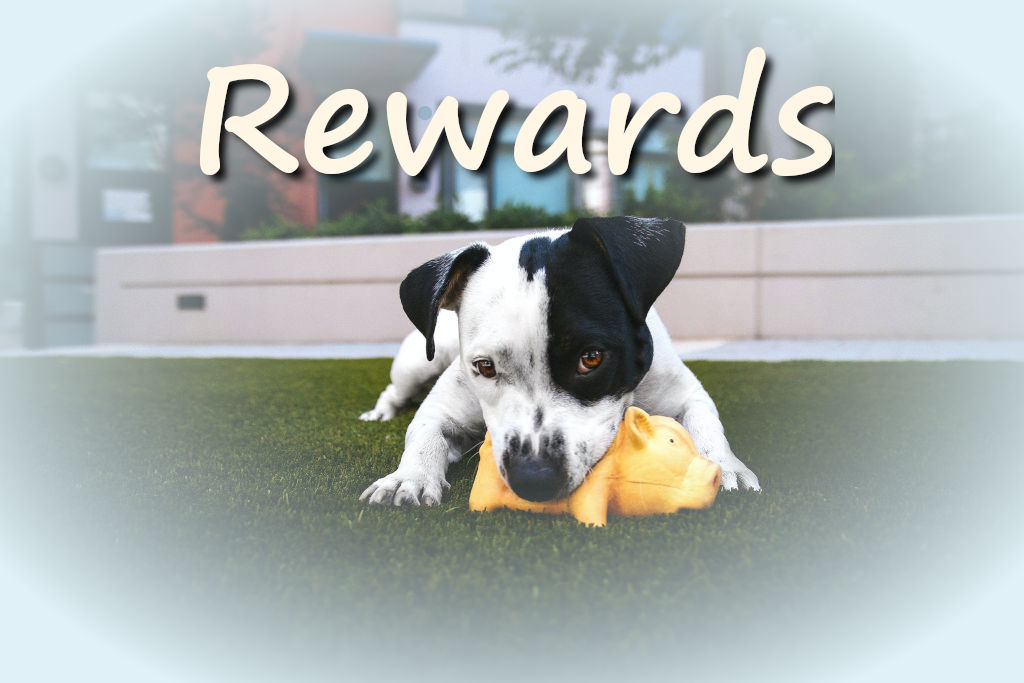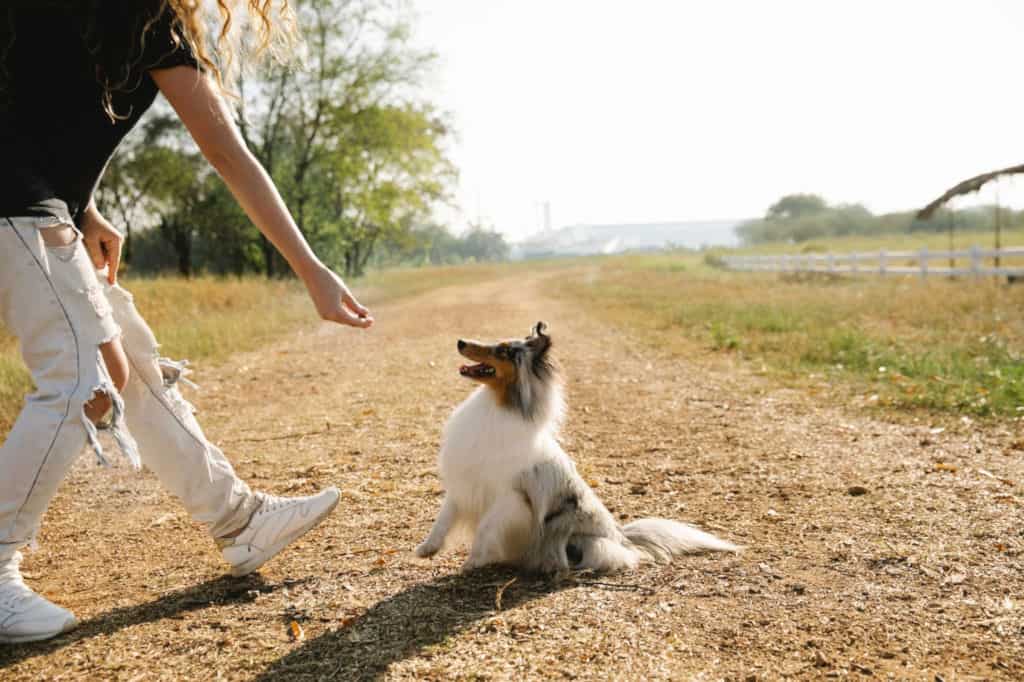Rewarding good behavior is a fun and effective way to strengthen the bond between you and your pup.
In this post, we’ll explore how using rewards can be a powerful tool in training your pet, and we’ll provide you with some tips to make the most out of your training sessions. Get ready to have some fun with your four-legged pal.

Set Your Dog Up for Success
Rewards play a crucial role in positive reinforcement training.
Each dog is unique, and what motivates one may not work for another. To effectively train your dog, it’s important to understand their preferences and motivations.
Using rewards correctly can make learning a fun and engaging experience, resulting in quicker progress and more reliable behavior. On the other hand, using the wrong rewards or not using them effectively can lead to a lack of interest or aversion to training, which can be counterproductive.
To avoid this, carefully choose meaningful and motivating rewards for your dog and use them consistently and appropriately.
A simple tip? Pay attention during your dog’s mealtime. Foods that make your pet sit up and take notice can often serve as excellent training incentives.
Understanding Your Dog’s Preferences
Once you know what your dog likes, you can choose rewards that are most effective for your pup, making training more successful.
Some dogs are more motivated by food rewards, while others may prefer play, attention, or affection. For example, a high-energy dog may find playtime with their owner the most rewarding, while a food-motivated dog may be more interested in receiving a treat for completing a task.
By identifying what your dog finds most rewarding, you’re not only making training more successful but also building a stronger bond with your furry friend.
Finding the Best Rewards for Your Dog
Observing your dog’s behavior and reactions can help you determine the rewards they prefer. Some dogs might be more motivated by food, while others might like toys or verbal praise.
Here’s how you can easily find your dog’s preferred reward type:
- Offer a variety of rewards. Try offering a piece of kibble, a small treat, a toy, or verbal praise, and see how your dog responds. Take note of which reward options they show the most interest in.
- Observe your dog’s reactions. Pay attention to your dog’s behavior and body language when they receive a reward. Do they eagerly accept it or seem uninterested? Do they get overly excited or become anxious?
- As you train your dog, keep a record of which rewards your dog responds to best, so you can use them in future training sessions.
These observations can help you understand what type of reward is most motivating for your dog.
Finding your dog’s preferred rewards might take some trial and error, but discovering what they like best can make training more effective and enjoyable for both of you.
When introducing new rewards, start in a distraction-free environment. This ensures your dog focuses entirely on the reward, giving you a clearer read on their preference.
Types of Rewards to Consider
When choosing the right reward for your dog, there are various options. Here are some common types of rewards that can be effective for training, with examples of when each will be most effective.
1. Treats and Snacks: Learning Fuel
Edible rewards are a favorite for many dogs. High-value treats like cheese, cooked chicken, or hot dogs can encourage learning new behaviors or complex tasks.
Remember to choose healthy options that consider your dog’s nutritional needs and keep portions small to prevent overfeeding.
2. Playtime and Toys: Stimulating Fun
Some dogs value playtime above everything else. Using a favorite toy as a reward can make training sessions more fun and interactive. This can be particularly effective for physical activities like agility or obedience training.
3. Praise and Love: Affectionate Rewards
Verbal praise or physical affection can be as rewarding as any treat or toy. For calm and obedient behavior in daily situations, rewards like a gentle pat, a belly rub, or a cheerful “Good boy/girl!” can go a long way.
4. Perks and Privileges: Extra Benefits
Offering your dog access to special resources can also serve as a strong motivation. This could be a favorite spot on the bed, a walk in the park, or even the chance to enter a room first. This type of reward works best for reinforcing behavior over a longer period.
Remember that the effectiveness of a reward will depend on your dog’s preferences, so feel free to experiment and find the right balance that suits your furry companion best.
While commercial treats have their place, sometimes the best rewards are those spontaneous moments of joy, like an impromptu game of tug-of-war or a surprise walk.

Factors to Consider When Choosing Rewards
Timing, consistency, and value are essential factors to consider when selecting rewards because they can greatly affect the effectiveness of the rewards in motivating and reinforcing desired behaviors in your dog. Here’s why they’re important.
Timing: When to reward
Rewarding your dog as soon as they perform the desired behavior can help reinforce the association between the behavior and the reward.
For example, if you’re teaching your dog to “sit,” reward them immediately after they sit down rather than waiting a few seconds or longer.
Consistency: Reward every time
Consistently rewarding your dog for the desired behavior can help reinforce the behavior and increase their chances of repeating it. If you’re teaching your dog to come when called, make sure to reward them every time they come rather than only occasionally or randomly.
Value: Finding the right incentive
The value of the reward you choose can impact your dog’s motivation to perform the desired behavior. If your dog is highly motivated by food, using a high-value treat like a piece of cheese or hot dog can be more effective than a lower-value treat like kibble.
Similarly, if your dog is highly motivated by play, a favorite toy or game can be a more effective reward than food.
Accessibility: Convenient rewards
Here are some tips for selecting convenient, accessible, and healthy rewards for your dog:
- Choose easily accessible rewards. This can include treats that you can keep on hand at home, or toys that are easily accessible for playtime.
- Consider the nutritional value of rewards. Choose healthy rewards for your dog, as they will consume them regularly. Look for options that are made with high-quality ingredients and that are nutritionally balanced.
- Keep rewards in moderation. This can help to avoid overfeeding or overstimulating your dog. Consider your dog’s daily caloric needs and use rewards in moderation to avoid overfeeding.
- Make rewards convenient for training. Ensure the rewards are easy to use. This might include choosing small, easily consumable treats that are quick to deliver, or using a toy that can be easily thrown or tossed during training sessions.
By keeping these tips in mind, you can choose rewards that are not only convenient and accessible but also healthy and effective for your dog’s training.
For dogs with dietary restrictions, toys or playtime can become invaluable rewards. Always have a toy or two in your pocket during training sessions.
Putting Rewards to Work
Now that you’ve identified your dog’s preferred rewards and learned the importance of choosing the right ones, it’s time to use them in your training.
Here are some key tips to help you get started and use the rewards for the best results.
a) Use Rewards Effectively
- Make sure to deliver the reward immediately after your dog performs the desired behavior, and in a way that is exciting and motivating for them. For example, if your dog is highly food-motivated, use high-value treats like small pieces of cooked chicken or freeze-dried liver.
- Use a consistent marker signal, like a clicker or a verbal cue, to let your dog know when they have performed the desired behavior correctly. This can help them understand what is being rewarded.
Pro tip: Be mindful of the environment in which you’re training your dog, as it may be difficult for them to focus. Start with a low level of distraction and slowly increase it as your dog improves.
b) Gradual Weaning: From Treats to Tricks
- Once your dog has consistently performed the desired behavior for several sessions, gradually increase the number of times they have to perform the behavior before receiving a reward.
- Replace the tangible reward with a non-tangible one, like verbal praise or physical affection, to show your dog they are doing a good job even when there is no physical reward.
Pro tip: Use a marker or a clicker to signal to your dog that they have performed the desired behavior, and that a reward is coming. This can help to reinforce the behavior and increase the likelihood of them repeating it in the future.
c) Adapting Rewards to Your Dog’s Changing Needs
- Pay attention to your dog’s behavior and body language during training sessions to see if they are still responding to the same rewards. If not, try introducing new ones that align with their current preferences.
- Don’t be afraid to mix up the type or frequency of rewards to keep your dog interested and motivated. For example, if your dog is getting bored with treats, try using a favorite toy or a special activity like playing fetch as a reward.
Pro tip: Vary the rewards based on the difficulty of the behavior. For easier tasks, offer lower value rewards, and for more challenging tasks, offer higher value rewards. This can help keep your dog motivated and engaged in the training process
Adapt rewards based on your dog’s energy levels at different times of the day. A morning session might call for playtime, while an evening session might be best paired with a tasty treat.

What to Avoid When Using Rewards
In this section, we’ll cover some common mistakes to avoid when using rewards in training, so you can help your furry companion learn and thrive. Here’s what not to do:
- Don’t use rewards that your dog isn’t interested in. Pay attention to your dog’s preferences and use rewards they find appealing.
- Avoid unhealthy rewards for your dog. Make sure to choose safe and healthy rewards for your dog, and avoid using rewards that could lead to weight gain, dental problems, or other health issues.
- Don’t use rewards inconsistently. Ensure to reward your dog every time they perform the desired behavior, and deliver the reward immediately after the behavior.
- Avoid punishing your dog for not performing a desired behavior or for making mistakes. Punishment can cause fear, anxiety, and even aggression in dogs, undermining the positive relationship you’re trying to build with them.
- Try not to use inappropriate rewards. Choose rewards that are appropriate for the behavior you’re trying to reinforce. For example, if you’re teaching your dog to come when called, a food reward may be more appropriate than a toy reward. Offering an inappropriate reward can confuse your dog.
By avoiding these common mistakes and following the tips and tricks outlined in this post, you can help your canine friend learn and thrive through the power of positive reinforcement training.
Conclusion: Rewards for a Happy, Healthy Dog
Choosing the right rewards for positive reinforcement training is key to building a strong bond between you and your four-legged friend. By understanding your dog’s preferences and motivations, you can select rewards that will be the most effective and lead to quicker progress and more reliable behavior.
Remember to use rewards immediately and consistently and to avoid punishments and inappropriate or unhealthy rewards. With some testing and patience, you can make learning a fun and engaging experience for both you and your faithful pup. Give it a try!
Alex, a passionate animal lover, has experience in training and understanding animal behavior. As a proud pet parent to two dogs and three cats, he founded AnimalReport.net to share insights from animal experts and expand his knowledge of the animal kingdom.









